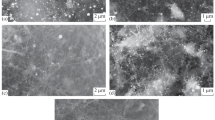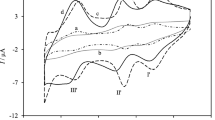Abstract
One-dimensional iron metallic nanotubes were prepared by electroless deposition within the pores of polycarbonate (PC) membranes. The longitudinal nucleation of the nanotubes along the pore walls was achieved by mounting the PC membrane between two halves of a U-shaped reaction tube. Palladium nanoparticles were post-deposited on the inner wall of the nanotubes. The composition, morphology, and structure of the Pd/Fe nanotubes were characterized by transmission electron microscopy, scanning electron microscopy, and inductively coupled plasma–atomic emission spectroscopy. A glassy carbon (GC) electrode modified with the free Pd/Fe bimetallic nanotubes (isolated after the dissolution of the host membranes) showed small improvement on the overpotential oxidation of ascorbic acid in comparison to the bare GC electrode. Alternatively, the Pd/Fe-polycarbonate membrane was covered with a sputtered gold thin layer of 10 nm from one side and mounted in a homemade electrochemical cell acting as the working electrode. The potential use of these functional membranes as catalytic surfaces for the electrochemical monitoring of ascorbic acid was investigated by cyclic voltammetry and amperometry. In the presence of a phosphate buffer solution, pH 7, Pd/Fe-polycarbonate membranes showed excellent electrocatalytic properties toward the oxidation of ascorbic acid even at potentials as low as 0 mV versus a Ag/AgCl reference electrode. In addition to the substantial lower overpotential, these electrodes offered selectivity over acetaminophen and uric acid, and a prolonged working stability without the need for maintenance. The electrodes were kept dry between different working days and retained their original activity for more than 1 week. Pd-polycarbonate and Fe-polycarbonate membranes were also developed for comparison purposes.

Palladium/iron bimetallic nanotubes is a promising material architecture for electrocatalysis





Similar content being viewed by others
References
Luo XL, Morrin A, Killard AJ, Smyth MR (2006) Electroanalysis 18:319–326
Privett BJ, Shin JH, Schoenfisch MH (2008) Anal Chem 80:4499–4517
Perez-Lopez B, Merkoci A (2011) Anal Bioanal Chem 399:1577–1590
Campbell FW, Compton RG (2010) Anal Bioanal Chem 396:241–259
Moreno M, Ibanez FJ, Jasinski JB, Zamborini FP (2011) J Am Chem Soc 133:4389–4397
Meng H, Xie F, Chen J, Shen PK (2011) J Mater Chem 21:11352–11358
Ksar F, Surendran G, Ramos L, Keita B, Nadjo L, Prouzet E, Beaunier P, Hagege A, Audonnet F, Remita H (2009) Chem Mater 21:1612–1617
Baron R, Wildgoose GG, Compton RG (2009) J Nanosci Nanotechnol 9:2274–2282
You JM, Jeon S (2011) Electroanalysis 23:2103–2108
Kim SK, Jeong YN, Ahmed MS, You JM, Choi HC, Jeon S (2011) Sensors Actuators B 153:246–2451
Lim SH, Wei J, Lin JY, Li QT, KuaYou J (2005) Biosens Bioelectron 20:2341–2346
Atta NF, El-Kady MF, Galal A (2009) Sensors Actuators B 141:566–574
Shaidarova LG, Gedmina AV, Cheinokova IA, Budnikov GK (2003) J Anal Chem 58:886–8891
Haehnel V, Fahler S, Schultz L, Schlorb H (2010) Electrochem Commun 12:1116–1119
Zahran EM, Bhattacharyya D, Bachas LG (2011) J Mater Chem 21:10454–10462
Menon VP, Martin CR (1995) Anal Chem 67:1920–1928
Xian YZ, Hu Y, Liu F, Xian Y, Feng LJ, Jin LT (2007) Biosens Bioelectron 22:2827–2833
Xiao P, Zhang YH, Garcia BB, Sepehri S, Liu DW, Cao GZ (2009) J Nanosci Nanotechnol 9:2426–2436
Kharton VV (2009) Solid state electrochemistry, 2nd edn. Wiley-VCH, Weinheim
Compton RG, Banks CE (2011) Understanding voltammetry, 2nd edn. Imperial College Press, London
Safavi A, Banazadeh AR (2011) Electroanalysis 23:1536–1542
Lowe RD, Mani RC, Baldwin RP, Sunkara MK (2006) Electrochem Solid-State Lett 9:H43–H47
Skoog DA, Holler FJ, Crouch SR (2007) Principles of instrumental analysis, 6th edn. Thomson Brooks/Cole, Belmont
Wen D, Guo SJ, Dong SJ, Wang EK (2010) Biosens Bioelectron 26:1056–1061
Stergiou DV, Diamanti EK, Gournis D, Prodromidis MI (2010) Electrochem Commun 12:1307–1309
Florou AB, Prodromidis MI, Tzouwara-Karayanni SM, Karayannis MI (2000) Anal Chim Acta 423:107–114
Florou AB, Prodromidis MI, Karayannis MI, Tzouwara-Karayanni SM (2000) Anal Chim Acta 409:113–121
Atta NF, El-Kady MF (2010) Sensors Actuators B Chem 145:299–310
Acknowledgments
This work was supported in part by the National Institute of Environmental Health Sciences (NIEHS). We also acknowledge funding from the University of Miami. M. I. Prodromidis thanks the University of Ioannina, Ioannina, Greece for granting a sabbatical leave. E.M.Z acknowledges the National Research Center, Egypt for granting an academic leave.
Author information
Authors and Affiliations
Corresponding author
Additional information
Mamas I. Prodromidis is on sabbatical leave: Department of Chemistry, University of Ioannina, Greece.
Elsayed M. Zahran is on academic leave: Department of Applied Organic Chemistry, National Research Center, Egypt.
Electronic supplementary material
Below is the link to the electronic supplementary material.
ESM 1
Additional EM images of Pd/Fe bimetallic nanotubes (PDF 899 kb)
Rights and permissions
About this article
Cite this article
Zahran, E.M., Prodromidis, M.I., Bhattacharyya, D. et al. Palladium nanoparticle-decorated iron nanotubes hosted in a polycarbonate porous membrane: development, characterization, and performance as electrocatalysts of ascorbic acid. Anal Bioanal Chem 404, 1637–1642 (2012). https://doi.org/10.1007/s00216-012-6291-1
Received:
Revised:
Accepted:
Published:
Issue Date:
DOI: https://doi.org/10.1007/s00216-012-6291-1




